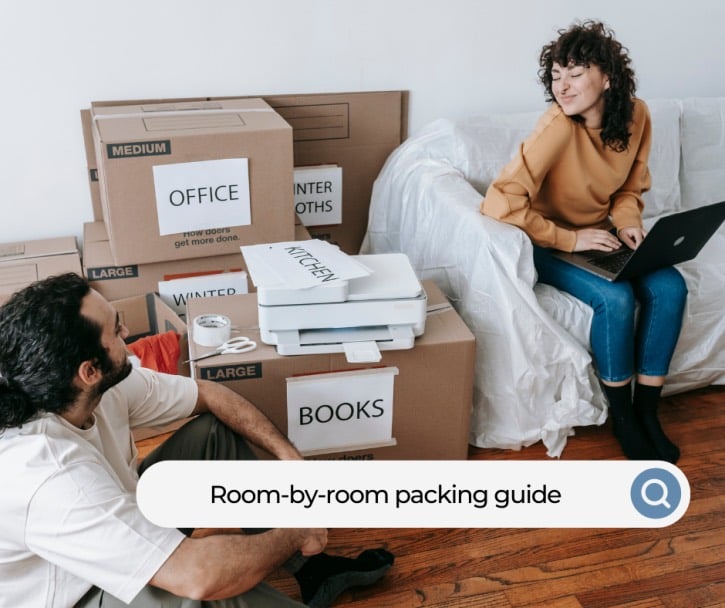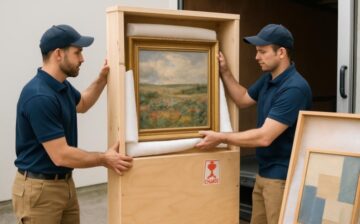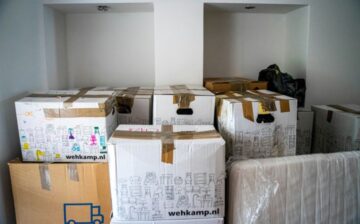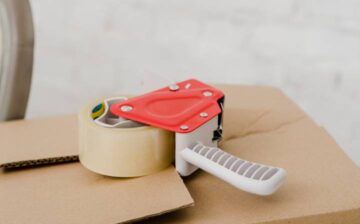
Moving is exciting – it’s a fresh start, a chance to discover new places and new people and there’s always a sense of adventure around it. However, the moving adventure also implies a good deal of stress, expenses, planning and headaches. At the same time, moving guides and checklists are technically supposed to help you, but out of the hundreds of ‘thorough’ and ‘ultimate’ moving guides out there…is it just an additional task to find a good one that suits you?
We’re here to help you in a different way. In other words, we won’t tell you how to plan and where to begin, but we’ll get down to brass tacks and tell you exactly what you need to do for a smooth and quick room-by-room pack. Why? Well, simply put, each room has its particularities when packing personal belongings. Additionally, we’ll drop in a few useful pieces of information about moving supplies you will probably need, as well as storage options that will ease the whole process.
How to properly pack your kitchen
As, All Around Moving Services Company, Inc. suggests, let’s start with this one since most people agree that it’s the hardest to deal with when packing. This does make sense, since it contains the highest number of items in any room, both large and small, and you will also need to use it right up to your moving day. Food is a sensitive matter, since people tend to either buy more food or keep ordering takeout before moving out, instead of emptying the pantry, fridge and freezer. Keep in mind that you can donate unperishable foods to a local soup kitchen or charitable organization, if you find yourself stuck with a good deal of food right before relocating.
Sensitive items that need to be moved include china, mugs, cups, plates, small appliances and many other similar belongings that are fragile. When dealing with these items, you should invest in sturdy boxes and avoid going for the cheaper options. When packing up your kitchen, it is essential to separate essentials from non-essentials. In other words, set aside a few things that you will need up until leaving and pack them up on moving day, in one single box. Just like with everything else, correctly labeling your boxes is extremely important. Even if it seems like an extra effort, you’ll thank yourself for the labels once you arrive in your new home.
Finally, kitchen appliances can easily be subject to damage during transportation, so some items need special care beforehand. This is the case with your fridge and freezer, for example, which need to be thoroughly cleaned, emptied and defrosted before your big moving day. The interiors should dry off before loading them onto the moving truck and getting behind the wheel, as closing and packing them up while still moist may generate unpleasant smells. Taping the doors shut during transportation is another must, as is taping the cables and hoses to the items themselves. This way, you’ll avoid damaging them during the journey.
A few extra tips to make things easier:
- Wrap individual plates in packing paper, Styrofoam or bubble wrap and store them in well-cushioned moving boxes.
- Place crumpled paper inside your glasses and wrap them in soft packing paper. Also, use boxes with cell dividers for more expensive glasses.
- Large kitchen knives and cutlery in general can be wrapped in thick towels, while oddly shaped utensils such as ladles or tongs should be wrapped individually.
- Both large and small kitchen appliances can sometimes be disassembled, so make sure to remove detachable parts, if possible, and pack them separately, properly labeling them.
- While food supplies should be used up before moving, bringing along your spices, wine collection or specialty oils is feasible, if done properly.
How to properly pack your bedroom
Along with the kitchen, your bedroom is a challenging area of the house when it comes to packing to move. Closets and drawers end up jammed with far more stuff than they should, from old Christmas party dresses to your gymwear, and properly packing your things may take a lot longer than initially planned. There is a certain process with specific steps to packing the belongings in your bedroom, and you should start with systematically sorting through your stuff. What stays and what goes? Getting rid of some personal items is recommended, as moving is a great opportunity for going through what you own and analyzing what you might not need in your new home.
Properly packing up your bedroom and moving your belongings is very important, as they will allow you to recreate the coziness and comfort of your old place in your new home. However, keep in mind that the bedroom should actually be the last room in your packing schedule — you will need a place to sleep, right? Of course, you can pre-pack some stuff, and only leave your bed and a change of clothes to deal with in the morning of your moving day. A few of the challenges that a bedroom poses include moving large pieces of furniture, packing mattresses, protecting lamps and small appliances, along with artwork, picture frames, etc.
Emptying the room of all its furniture is essential before even thinking about packing up and moving. Disassembling large pieces of furniture, including your bed, if possible, is recommended. Moving blankets should be used for large and oddly shaped belongings, while bubble wrap is the preferred moving supply in the case of smaller pieces. At the same time, zip-lock bags are perfect for hardware parts that are detached and then assembled again. Just like in the case of fridges, it is important to secure doors, so they are not subject to damage during transit. Additionally, mirrors and glass panels should be removed beforehand, packed and stored separately.
Besides being a challenge to pack up, bedrooms also represent a good yardstick when considering self storage. Renting a storage space when moving is extremely helpful, and if you choose to rent one close to your new home, you can store your stuff there as you pack it. People often tend to think about self storage units in terms of numbers of bedrooms – while the standard 10’x10’ unit can store the belongings of a small one-bedroom apartment, bigger 10’x15’ or 10’x20’ spaces can hold everything from a 2/3-bedroom house and a 3+bedroom home, respectively. In case you’re still unsure about the type of unit you need, this size guide will help you.
Finally, when it comes to your bedroom, don’t forget that:
- Special mattress bags are a thing – look them up and get one, they’re worth it
- Furniture pads are important when moving large wardrobes
- Pack your clothes according to season, material and size
- Shoes are ideally packed in shoeboxes, filled with crumpled paper
- Protect mirrors with cardboard, bubble wrap and even moving blankets for safe transport
How to properly pack your living room
Preparing your living room stuff for moving combines the challenges of packing both kitchens and bedrooms. On the one hand, it might seem a bit overwhelming to deal with objects of so many sizes and shapes, while on the other hand, the living room is also a space that is used until the moving truck pulls into your driveway. Moreover, as the living room is usually the largest room in the house, it makes sense that it takes plenty of time to pack. Let’s get into it and see how we should cope with packing books, furniture, electronics and all kinds of knick-knacks.
Starting with furniture, you should detach elements where it is possible, and pack these pieces accordingly. Upholstery should be protected from dirt and dust with simple plastic wrap — and moving blankets, in the case of larger pieces of furniture. Tables can also pose a challenge but wrapping legs to secure them and folding cardboard around corners are much needed safety precautions. Large cardboard boxes, on the other hand, are perfect for folded curtains and rugs, but keep in mind that rugs are best rolled and secured with plastic ties.
Seeing that the modern American living room is increasingly replete with electronics, knowing how to handle, pack and transport these makes all the difference in the world. In the case of TVs, it is crucial to secure cables and wires with straps and store accessories and smaller hardware parts appropriately in bags. Screens must be protected with cardboard, while soft blankets and stretch wraps will provide additional safety. You’re in luck if you happen to still have your TV’s original box. The same goes for other devices, except for speakers and stereo equipment, which require special care. Speakers should be wrapped in anti-static wrap, moving boxes need to be well-padded and sturdy, while special cases and crates must be considered for turntables, discs, tapes and other similar technical equipment.
A few extra tips to make packing your living room easier:
- Remove all media from electronics before packing and label detachable cords
- Pack the largest pieces in the bottom of the box and fill the rest with packing paper
- Pack books that are roughly the same size together and use double-sided tape for them
- When packing lamps, remove the bulb and harp before disassembling the lamp
- Use shrink wrap for the furniture but poke holes in it so it can breathe during the journey
How to properly pack your bathroom
Cheer up, here’s where it gets slightly easier. The bathroom is typically the smallest room in the house, and even though it takes some effort to go through all your belongings there, at least it won’t take up too much time. However, you will have to deal with dozens of half-used containers and tubes and decide whether to keep or discard many of your bathroom products. It is important to start by sorting through your toiletries and medications before packing them, and it is just as important to safely dispose of stuff that you don’t need anymore.
Start by throwing away everything that’s dried out or expired, including boxes that have no labels. Hazardous products can pose problems, and that is why hairsprays, deodorants, flammable products and toiletries that contain alcohol should either be used up before moving or transported separately, in a safe manner. Separating these items is key – use bubble wrap and padded bags with several pockets and pouches so you can have skin care products in one place and hair products in another spot, for instance.
If you go with moving boxes, it is important to pack your toiletries tightly, so they don’t bounce around and damage each other. Essentials, such as shampoo, shower gel, toothbrushes, toothpaste, toilet paper, hairbrushes and everyday makeup, among other things, should be kept separately, as you’ll need them during the last days in your old home and during the first few ones in your new place.
Towels, linen and shower curtains should only be packed when completely dry. Folding them is recommended before storing them in plastic bags or large boxes. Remember that towels can even be used as padding in your moving boxes.
Don’t overlook these bathroom-specific packing tips:
- Movers won’t load flammable cosmetic products onto the moving truck, so you’ll have to take care of them yourself
- Likewise, many cosmetic products are heat- or cold-sensitive and require special attention during the packing and moving phases
- Fragile items such as perfume vials and glass containers must be wrapped appropriately
- Cleaning supplies, chemicals and paint are also hazardous materials that need special care
How to properly pack your garage or shed
This is something that applies, in fact, to any storage space you might have around the house, be it a garage, a basement, an attic or an outdoor tool shed. These tend to be overstuffed catch-all storage areas that people think about last when it comes to packing. However, depending on how organized you are, a garage can also be a dumping ground for stuff that you forgot was there in the first place – old appliances, boxes and tools, clothes and even furniture. It’s usually large pieces that are stored in these areas, and they don’t necessarily need to be boxed up, but that doesn’t mean they don’t require your full attention before the move.
Start by sorting through what you have and try to identify the gear that has outlived its purpose, equipment that you shouldn’t bother bringing to your new home. Don’t load up unopened boxes just to end up placing them in your new garage — it won’t do you any good. It might not be a bad idea to actually start your packing process here, if you know you’ll have a lot of old personal belongings to sift through.
Oils, paints, pesticides and fertilizers are a few hazardous materials that should not be transported. Consequently, either use them up or find a way to dispose of them properly. Cars and other vehicles should be shipped with auto transport companies or kept in a storage unit close to your new home. Outdoor furniture, on the other hand, should again be dismantled and the pieces wrapped and packed separately. Either label these pieces accurately, so you know where they belong, or tape them to the furniture they belong to. Gas-powered tools should be drained of fuel and packed in protective covers, removing detachable parts. The same goes for power tools and any other garden implements – dismantle them if possible, pack them in strong cardboard boxes (or in the original boxes, if you still have them) and group them according to size and purpose.
Finally, consider renting a self storage unit for these, as it will be useful even after the move is over. Cars and other vehicles, along with outdoor furniture and tools, are some of the items most frequently put into self storage units. This way, you’ll know they are in a safe place, they won’t clutter your new home, and you can pick them up when you need them next.
Safety is the name of the game when packing your garage, so have these tips in mind:
- Sharp-edged tools can be protected with packing paper, plastic wrap and even an extra towel. Towels and linens can also be used to fill up space between boxed items.
- Grouping and packing your items together according to their size and purpose will make unpacking considerably easier.
- Bike boxes are a thing, and despite the fact that they can be pricey, this is the way to go if your bike is valuable to you.
- Pack essentials that you might need quickly in your new home separately. This box can contain a hammer, a drill and similar tools.
To sum up
Finally, we know that moving is a time-consuming and stressful endeavor that almost everybody goes through at some point. We are confident that preparing for your big move by packing up each room of your home is the easiest way to go about it, and we hope these tips can ease your mind and (if you get rid of some stuff) the burden of your moving truck.
We hope you found this blog post Packing when moving: A thorough room-by-room Guide, useful. Be sure to check out our post 10 Moving and Packing Hacks for a Stress-Free Move for more great tips!
Have Experience in the Moving Industry? Want an Additional Income Stream? Work With All Around Moving!
Start a profitable business and work from anywhere. We provide everything you need. Check out our program to earn extra income. Click here to learn more.





